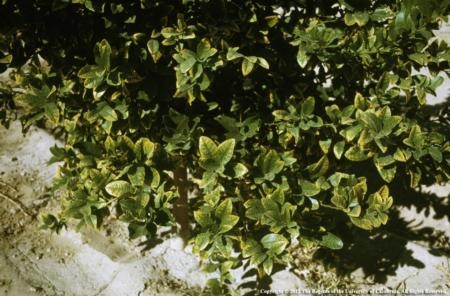- Posted By: Chris M. Webb
- Written by: Larry Lindgren, Grower and Ben Faber, Farm Advisor
There are many changes going on in the citrus industry and one opportunity is the conversion of an orchard to another variety of citrus. If this is a consideration, then the question becomes one of whether the orchard should be topworked or replanted with new nursery trees. If the trees are healthy and under 20 years of age (it is possible to topwork older trees) and the new scion is compatible with the interstock or rootstock, then topworking can come into production sooner than a new replant. If the planting density needs to be changed or serious soil preparation or a new irrigation system needs to be installed, then replanting might be the preferred choice.
The chance to convert is also dependent on the availability of new trees and budwood. New varieties can often be in short supply. It’s best to make sure that for either option that the material is there. For topworking, T-budding is more conservative of material than stick grafting. If topworking is chosen, then it must be decided whether to graft the scaffold branches or the stump. Stump grafting makes for a lower tree, but scaffold grafting reduces the risk of losing the topworked tree from damage to the graft from birds, pests, wind or frost.
It is often assumed that topworking is cheaper than replanting, but as the following example shows, it probably is not. In Santa Paula, ‘Olinda’ Valencias on ‘Carrizo’ rootstock were converted to scions ‘Allen’ Eureka lemon, or ‘Powell’ late navel. In 1998 and 2000, the ‘Olinda’s were interplanted with either ‘Allen’ on ‘Macrophylla’ or late navel ‘Powell’ or ‘Chislett’ (on either ‘Carrizo or ‘C-35’ rootstocks). The ‘Olinda’s were topworked in 2002 and 2003 to one of the new scions. In a few cases, ‘Allen’ was stump grafted, but most trees were scaffold grafted.
Several steps are required for topworking that will ensure success. These are listed below:
• Get a reputable person to do the work.
• Time of year is critical for grafting. Spring is best.
• Leave a nurse limb.
• Decide to stump or scaffold graft.
o Stump grafting requires only 3 – 4 buds or sticks
o Scaffold grafting requires 2 buds per scaffold. Consider winds since even one-year old unions are very tender.
• Sequence of events
o Line up budwood
o Remove top of tree and stack brush
o Whitewash trunks
o Paint cutoff surfaces
o Insert grafts
o Wrap grafts with plastic tape
o Place white paper bag over grafts and tape in place
Later
o Keep after ants and snails
o Shred brush
o Remove bags when shoots start growing through them.
o Bi-monthly, in first year, brush out water sprouts. Less often in the next 2 years
Much of this work can be contracted with the grafter, who usually assures some level of performance, something like 90% take. It is up to the grower to ensure that pests do not take out the grafts.
The costs of topworking are associated with the costs of the budwood (as much as $3 per tree), the act of grafting (depending on stump or scaffold, $8-10 per tree) and water sprout removal. Sprout removal is six times in year one, eight times in year two and only four times in year three. At a labor rate of $12 per hour, sprout removal costs $7.20 per tree.
A like for like comparison of topworking versus replanting based on 2002 data is shown below.
So in the case of both the lemon and navels it costs a bit more to topwork, but the results are earlier production. Here the topworked trees gain the economic advantage. For example, if cultural costs were $1000 per acre per year (20 by 20 ft. spacing) and, conservatively, two years are saved, the maintenance savings per tree would be $18. In the above study the time advantage appears even greater. Three-year old topworked lemons produce about the same as 6-year old replants. Two year old topworked navels have a significantly larger canopy than six-year old replant navels and appear to have about the same fruit set for the coming year.

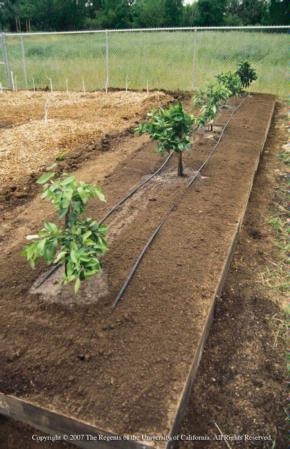
- Posted By: Chris M. Webb
- Written by: Neil O’Connell, Farm Advisor
Deficit irrigation research by Dr.David Goldhamer has yielded some interesting results in navel oranges. In the original trial on mature, vigorous Frost Nucellar navels on a sandy loam soil, applied water was reduced by varying amounts and at different times during the irrigation season depending upon the treatment imposed. Regulated deficit irrigation is applying a fixed % less than the full water requirement of the tree during a specific period in the irrigation season.
The fully irrigated control trees received a volume of water estimated to be the tree water requirements based upon size and current weather conditions –using the current water requirements of a pasture grass (Eto cimis station) multiplied by a crop factor for mature citrus which is 0.65. The objective of the trial was to determine if the volume of applied water could be reduced by varying amounts and at different times during the irrigation season compared to a fully irrigated control without a loss in yield or quality and perhaps improved peel appearance. Measurements were made of fruit growth during the season and of yield and fruit quality at harvest; the amount of water applied with each treatment was measured as well. Research conducted over the years has indicated that citrus was sensitive to reduced irrigation particularly at petal fall and during early fruit development with loss in yield or fruit size.
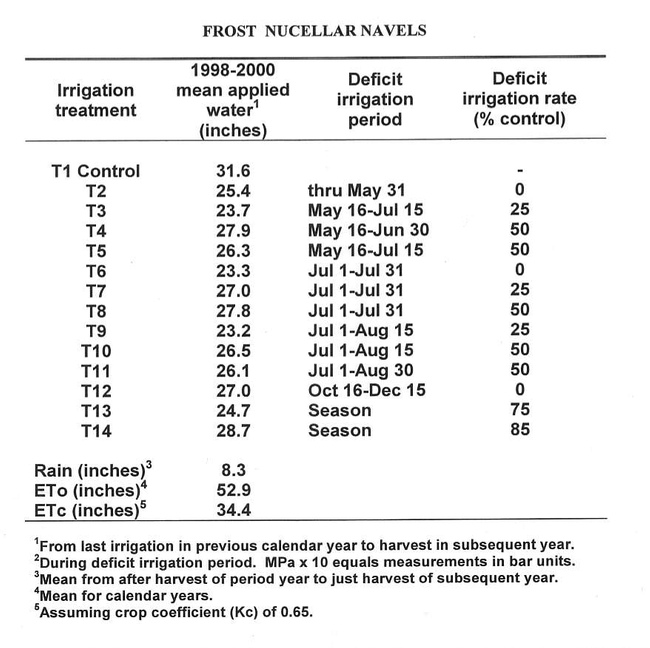
The current study indicated that where deficit irrigation was applied, a slowing in growth rate of the fruit was observed compared to the fully irrigated tree, but when full irrigation was resumed at the end of the treatment period, accelerated growth occurred compared to the control trees. Yield at harvest was not significantly different among any of the reduced irrigation treatments compared to the fully irrigated control trees. There was also no difference in number of fruit per tree or packable cartons among the treatments compared to the control. An additional result was that there was significantly less creasing of the peel in two of the treatments--T2 and T3-- compared to the fully irrigated trees. Both of these treatments imposed stress early in the season and reduced applied water by 6.2 and 7.9 inches, respectively. This equates to 19.6 and 22.8% less applied water than the fully irrigated control. This research demonstrated that less than the full water requirements of the tree can be applied at specific times during the fruit development period under controlled and known conditions without a loss in yield.
Ongoing research on Lane Late navels is being conducted with the object of reducing granulation by regulating fruit size for an optimum fruit size at harvest. Fruit held late for harvest frequently results in a significant portion of the fruit being large. Historically large fruit have a higher percentage of the fruit with granulation. This fruit may be less than optimum size (too large) for current market conditions as well. Based upon the previous regulated deficit irrigation study the object of the current trial is to regulate size based upon imposed stress by applying less than full irrigation during specific periods in the irrigation season that is early, mid and late season stress.
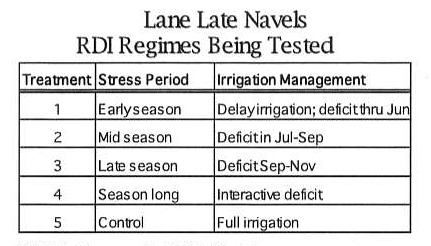
Less water is applied than required by a fully irrigated tree for the period, and growth of the fruit is monitored compared to the fully irrigated tree. Adjustments are made in applied water based upon the growth of the fruit in the stress tree as well as measured tree water status (pressure chamber) compared to the fully irrigated control. The same type of response to the deficit irrigation that occurred with the Frost Nucellar has been observed. A slowing of growth under the deficit irrigation, then accelerated growth with resumption of full irrigation. However, this study imposes stress over longer periods that the previous study and thus, the desired reductions in fruit size at harvest have occurred in all but the T1 treatments. The first year of the study, when fruit loads were relatively high, showed that early season stress reduced granulation (6.5% for all sizes vs. 17% for the control) with no effect on size. Continuous stress reduced both granulation (mean of 3.8 for all sizes vs. 17% for the control) and fruit size. In the second study year with lower fruit loads, there was no reduction in fruit load but fruit size was reduced to a greater extent in the mid, late summer, and continuous stress treatments. This reduced the percentage of unwanted very large size (24 and 32 count) fruit such that revenue to the grower was higher by from $1300 to $3000 per acre, depending on whether 24s and 32s were considered marketable.
Deficit irrigation imposes a level of stress on the tree related to the amount of water that the tree is shorted compared to a fully irrigated tree. The tolerance of the tree to this stress is related to the vigor of the tree, the period in the fruit development cycle, weather conditions, and how long the stress continues, and the magnitude of the stress. Under the conditions of these studies the level of stress imposed is carefully monitored and the deficit irrigation treatments are under known conditions and are carefully controlled. Where conditions are not known by the grower the trees may already be under some stress, the vigor of the trees may not be high; the irrigation system may not be uniform and therefore not delivering the expected volume. Attempting deficit irrigation under these circumstances runs the risk of reducing yield perhaps seriously as well as fruit size.
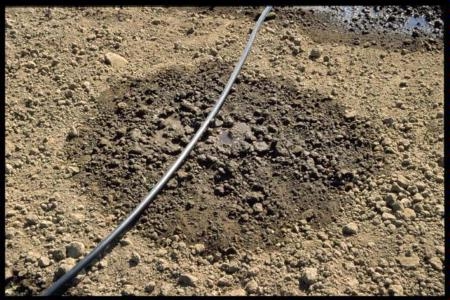
- Author: Neil V O'Connell
Recently a six-year old W. Murcott orchard was evaluated for causes of tree decline. A high percentage of the trees exhibited damage to the bark of the tree generally from the soil line up 6-8 inches. (Fig.2) In some instances the tree had been almost totally girdled. On close inspection of the trunk, an open hole 4-5 inches in diameter was found at the base of the tree. (Fig.3)
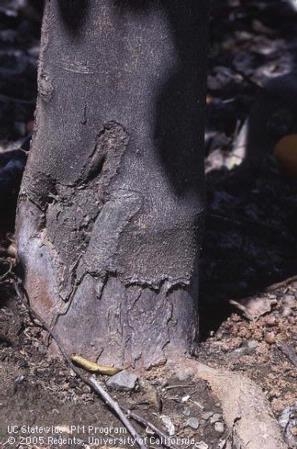
Microtus are often found where there is grass cover. They generally do not invade cultivated crops until the crop is tall enough to provide food and shelter. Meadow mice are active all year round. They forage at any time during the day or night but are chiefly nocturnal. They are usually found in colonies marked by numerous -2-- inch wide surface runways though matted grass. Small piles of brownish feces and short pieces of grass stems along the runways are evidence of activity. The burrows consist of extensive underground tunnels, nest chambers and storage chambers. Home range is typically small, less than a 60 foot radius in the case of “M.californicus”. All meadow mice swim well. Therefore, irrigation ditches will not serve as effective barriers against meadow mice movement into fields. Meadow mice may forage beyond the sheltered runways. Food consists of tubers, roots, seeds, grain, and succulent stems and leaves.
Females breed at 4 to 6 weeks of age with liter size of “M.californicus” averaging around 4. Under natural conditions a female Microtus may produce from 5 to 10 litters a year. The major breeding season corresponds with the season of forage growth. Microtus populations build up to a peak every 3 to 4 years, followed by a rapid decline during the next breeding season. The exact causes of the cycle of buildup and decline are not known, though disease, food shortages, physiological stress from overcrowding, and other factors may be involved. It is assumed that in cultivated areas Microtus populations are permanently based in favorable habitat such as roadsides, canal banks or adjacent noncultivated land. Invasion of cultivated cropland occurs when the population builds up or when the wild habitat becomes unfavorable. Coyotes, badgers, weasels, snakes, hawks, owls, herons and gulls are among the principal predators. It is believed that predators are not able to prevent or control a population eruption because of the birth rate of the fast breeding Microtus population. Meadow mice are classified as nongame mammals by the California Fish and Game Code. Nongame mammals, which are found to be injuring growing crops may be taken at any time or in any manner by the owner. Management: The most effective management options in an orchard situation are a reduction in ground cover and the use of toxic baits. Meadow mice are cover dependent. If cover is the management of choice - typically weed or grass, the cover can be removed from around the base of a tree, this often solves meadow mice problems. In situations where cover removal is not possible or is insufficient to solve the problem, the next best option is the use of toxic baits. Many bait carriers are used (e.g., oat groats, wheat bait). Baits: Crimped oat groats is the most satisfactory bait although crimped whole oats are used (e.g., oat groats, wheat grains, pelletized formulations, etc., but crimped oat groats have typically been most effective). The primary toxicants used for meadow mouse control include zinc phosphide, diphacinone, and chlorophacinone. Directions for management including baiting can be obtained by contacting the Agricultural Commissioner’s Office.
* Portions taken from J.P.Clark Vertebrate Pest Control
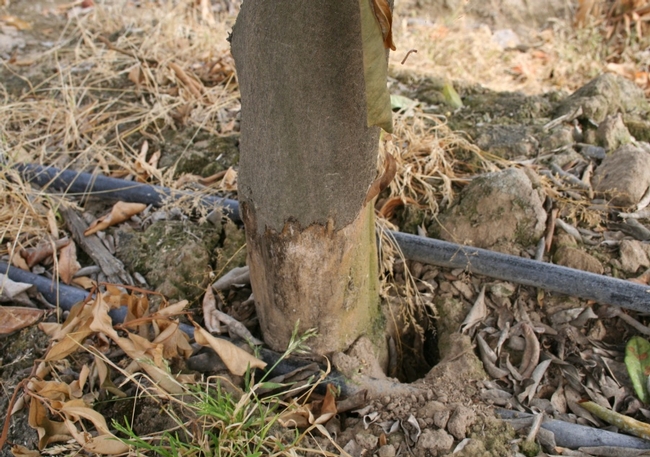
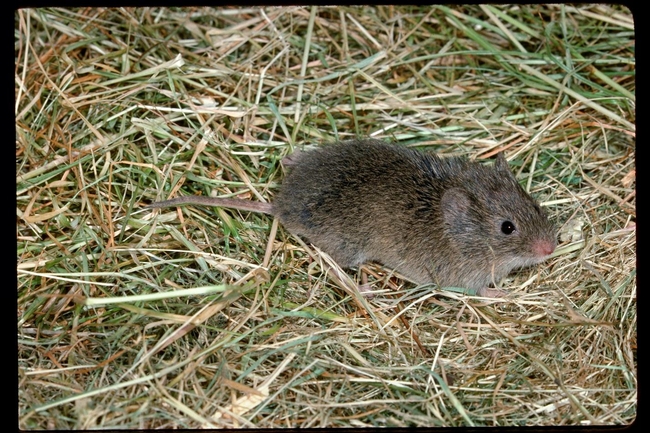
- Written by: Craig Kallsen
University of California (UC) researchers and private industry consultants have invested much effort in correlating optimal citrus tree growth, fruit quality and yield to concentrations of necessary plant nutrients in citrus (especially orange) leaf tissue. The grower can remove much of the guesswork of fertilization by adhering to UC recommendations of critical levels of nutrients in the tissues of appropriately sampled leaves. Optimal values for elements important in plant nutrition are presented on a dry-weight basis in Table 1. Adding them in appropriate rates by broadcasting to the soil, fertigating through the irrigation system or spraying them foliarly may correct concentrations of nutrients in the deficient or low range. Compared to the cost of fertilizers, and the loss of fruit yield and quality that can occur as a result of nutrient deficiencies or excesses, leaf tissue analysis is a bargain. At a minimum, the grower should monitor the nitrogen status of the grove through tissue sampling on an annual basis.
Leaves of the spring flush are sampled during the time period from about August 15 through October 15. Pick healthy, undamaged leaves that are 4-6 months old on non-fruiting branches. Select leaves that reflect the average size leaf for the spring flush and do not pick the terminal leaf of a branch. Typically 75 to 100 leaves from a uniform 20- acre block of citrus are sufficient for testing. Generally, the sampler will walk diagonally across the area to be sampled, and randomly pick leaves, one per tree. Leaves should be taken so that the final sample includes roughly the same number of leaves from each of the four quadrants of the tree canopy. Values in Table 1 will not reflect the nutritional status of the orchard if these sampling guidelines are not followed. Typically, citrus is able to store considerable quantities of nutrients in the tree. Sampling leaves from trees more frequently than once a year in the fall is usually unnecessary. A single annual sample in the fall provides ample time for detecting and correcting developing deficiencies.
Table 1. Mineral nutrition standards for leaves from mature orange trees based on dry-weight concentration of elements in 4 to 7 month old spring flush leaves from non-fruiting branch terminals.
|
element |
unit |
deficiency |
low |
optimum |
high |
excess |
|
|
|
|
|
|
|
|
|
N |
% |
2.2 |
2.2-2.4 |
2.5-2.7 |
2.7-2.8 |
3.0 |
|
P |
% |
0.9 |
0.9-0.11 |
0.12-0.16 |
0.17-0.29 |
0.3 |
|
K (Calif.*) |
% |
0.40 |
0.40-0.69 |
0.70-1.09 |
1.1-2.0 |
2.3 |
|
K (Florida*) |
% |
0.7 |
0.7-1.1 |
1.2-1.7 |
1.8-2.3 |
2.4 |
|
Ca |
% |
1.5 |
1.6-2.9 |
3.0-5.5 |
5.6-6.9 |
7.0 |
|
Mg |
% |
0.16 |
0.16-0.25 |
0.26-0.6 |
0.7-1.1 |
1.2 |
|
S |
% |
0.14 |
0.14-0.19 |
0.2-0.3 |
0.4-0.5 |
0.6 |
|
Cl |
% |
? |
? |
<0.03 |
0.4-0.6 |
0.7 |
|
Na |
% |
? |
? |
<0.16 |
0.17-0.24 |
0.25 |
|
B |
ppm |
21 |
21-30 |
31-100 |
101.260 |
260 |
|
Fe |
ppm |
36 |
36-59 |
60-120 |
130-200 |
250? |
|
Mn |
ppm |
16 |
16-24 |
25-200 |
300-500? |
1000 |
|
Zn |
ppm |
16 |
16-24 |
25-100 |
110-200 |
300 |
|
Cu |
ppm |
3.6 |
3.6-4.9 |
5 - 16 |
17-22? |
22 |
*California and Florida recommendations for K are sufficiently different that they are presented separately. The California standards are based on production of table navels and Valencias, and those for Florida were developed primarily for juice oranges like Valencia.
The sampled leaves should be placed in a paper bag, and protected from excessive heat (like in a hot trunk or cab) during the day. If possible, find a laboratory that will wash the leaves as part of their procedure instead of requiring the sampler to do this. Leaf samples can be held in the refrigerator (not the freezer) overnight. Leaves should be taken to the lab for washing and analysis as quickly as is feasible.
Often separate samples are taken within a block if areas exist that appear to have special nutrient problems. The temptation encountered in sampling areas with weak trees is to take the worst looking, most severely chlorotic or necrotic leaves on the tree. Selecting this type of leaf may be counter-productive in that the tree may have already reabsorbed most of the nutrients from these leaves before they were sampled. A leaf-tissue analysis based on leaves like this often results in a report of general starvation, and the true cause of the tree decline if the result of a single nutritional deficiency may not be obvious. Often in weak areas, it is beneficial to sample normal appearing or slightly affected leaves. If the problem is a deficiency, the nutrient will, generally, be deficient in the healthy-looking tissue as well.
Groves of early navels that are not normally treated with copper and lime as a fungicide should include an analysis for copper. Copper deficiency is a real possibility on trees growing in sandy, organic, or calcareous soils. For later harvested varieties, leaves should be sampled before fall fungicidal or nutritional sprays are applied because nutrients adhering to the exterior of leaves will give an inaccurate picture of the actual nutritional status of the tree.
Usually leaf samples taken from trees deficient in nitrogen will overestimate the true quantity of nitrogen storage in the trees. Trees deficient in nitrogen typically rob nitrogen from older leaves to use in the production of new leaves. Frequently, by the time fall leaf samples are collected in nitrogen deficient groves, these spent spring flush leaves have already fallen. Nitrogen deficient trees typically have thin-looking canopies as a result of this physiological response. Since the spring flush leaves are no longer present on the tree in the fall when leaves are sampled, younger leaves are often taken by mistake for analysis. These leaves are higher in nitrogen than the now missing spring flush leaves would have been and provide an inaccurately higher nitrogen status in the grove than actually exists.
Critical levels for leaf-nitrogen for some varieties of citrus, like the grapefruits, pummelos, pummelo x grapefruit hybrids and the mandarins, have not been investigated as well as those for oranges. However, the mineral nutrient requirements of most citrus varieties are probably similar to those for sweet oranges presented in Table 1, except for lemons, where the recommended nitrogen dry-weight percentage is in the range of 2.2- 2.4%.
A complete soil sample in conjunction with the leaf sample can provide valuable information on the native fertility of the soil with respect to some mineral nutrients and information on how best to amend the soil if necessary to improve uptake of fertilizers and improve water infiltration.
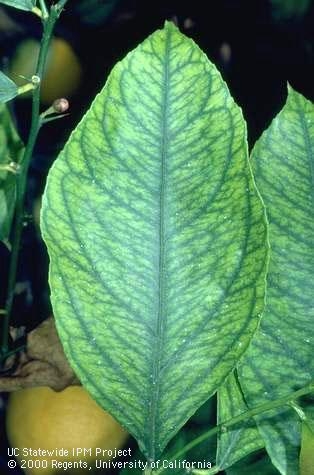
- Written by: Jim Downer
Horticulture is the cultivation of plants as ornamentals or for the production of food. When things go wrong (plants grow poorly or not at all), horticulturists sometimes turn to products that can “cure”, revitalize, invigorate, stimulate or enhance the growth of their plant or crop. A horticultural consultant colleague of mine, has often told me, “There are no miracles!” Unfortunately, when nothing else has worked, many people will turn to so called miracle products in hopes of a cure. Products that purport to give you that miracle are termed snake oil. Snake oil products claim many things, but usually without referenced research reports from Universities. Snake oil products almost always offer numerous testimonials to support their use. Those who provide testimonials are usually not researchers. Professional horticulturists, farmers and gardeners should be able to recognize snake oil products and avoid their use—we should base our horticultural decisions on sound research based information, not on marketing claims and testimonial based admonitions.
Science Based
The most creative and effectively marketed snake oil products often cite sound biological facts or knowledge and then attempt to link their product to this knowledge, but references to the published research about their product are always missing. Very often, snake oil products will use jargon relating to the chemistry, biology or microbiology of their products in an attempt to impress potential users with terms that sound informative but are used in a meaningless context. In some cases, these products are “ambulance chasers” and follow the most recent pest outbreak or natural disaster in an attempt to make money from desperate clients.
Works on a new principle
A prime indicator of snake oil products are that they rely on a new principle that gives them their efficacy. This “new” principle may be entirely fabricated by the manufacturer or have a shred of truth based in current science, but the science is so distorted that there is no truth in the claim. Very often the active ingredient is not listed on the label and is a “secret” or proprietary substance. A clear explanation of the scientific principle, its discoverer, where it was published and how it relates to the product at hand is rarely or never available.
Research Based
Some products make claims of efficacy based on extensive research. But who did the research? Upon inspection, we find that independent, third party research, published in a peer reviewed journal is lacking. In house research or research conducted by contract with other companies may not have the same degree of objectivity as University based research projects. Some products allude to University research but never tell the user that the research found that their product was not effective. Sometimes product literature tells outright lies about the efficacy of the product discussed in the research.
Sometimes a retired researcher will start selling a product based on the good research they have done in the past, but with little bearing on the efficacy of the current product or material. Past affiliations with Universities are no guarantee that products developed after the researcher has left the institution are efficacious. Only current, published reports of efficacy in peer reviewed journals are acceptable references.
Snake oil products can sometimes be lawbreakers!
Products that purport to control a pest such as a disease organism or an insect or weed, but are not registered with the State or Federal EPA and do not have pesticide registration numbers, are not pesticides and can not be used for that purpose. It is a violation of state and federal laws to apply products as pesticides when they are not labeled for that use. Sometimes a product claims to boost plant health and thus avoid diseases, also avoiding the pesticide registration process. Health boosters, activators, and stimulators are not considered pesticides by regulatory agencies; however, they are often not efficacious or supported by University research findings.
It is too good to be true
Some problems like Armillaria (which causes root rot and basal cankers of many ornamental and orchard trees) are essentially incurable. All the traditional sources of information suggest ways to limit the disease but no “cure” is offered. Along comes a product that kills the pathogen and reinvigorates the sick host. Sounds too good to be true? Then the product is probably snake oil. Rarely do efficacious pest management practices or products come to market without some kind of University based research. Again, there are no miracles.
Soil Microbiology Products and Services
All plants have root systems and almost all are rooting in soil, and since we do not see their roots very well, there is a lot of snake oil that concerns soils and soil treatments. Polymers, growth activators, hormones, vitamins, fertilizers, worm castings, composts and their teas, are but a few products that may fall into this category. Since none of these products claim to be a pesticide, the careful efficacy testing required for state or federal registrations is not required. Efficacy claims can run to the extreme.
Mycorrhizal Fungi
Some of the most convincing products are those that have solid scientific basis for efficacy but no direct evidence that they work. A classical example is fungal mycorrhizae forming inoculants for landscape trees. Mycorrhizae are not snake oil. However, some products that purport all the things that mycorrhizae can and do achieve for plants may be. Many of the numerous scientific papers written on mycorrhizal fungi do not indicate that mycorrhizae are necessarily lacking from most soils, or that the products used to add them to soil are viable. In a study of ten commercial mycorrhizae products, Corkidi et al.(2004), found that four of the ten failed to infect the bioassay plants and in a second trial, three of the ten products failed to infect.
Biological control
A considerable amount of time is spent each year by companies producing biological control microorganisms. Although these often show good efficacy in university based laboratory or greenhouse trials, and this research is published, there are few products that show efficacy in field-based trials. Many of the Trichoderma based products simply do not work when applied as products outside the lab or greenhouse. Biological control of soilborne diseases is an elusive thing that we seek to understand constantly, catch glimpses of in the field, study intensively and consistently fail to recreate when and where we want it to happen. Rarely has a single organism been applied with disease control effect in field settings. Soil ecosystem level changes (like massive mulch applications) can promote biological control of root rot diseases, but these effects are caused by many kinds of fungi that are naturally occurring in the environment.
Soil Food Webs
Manipulation of Soil Food Webs is purported to balance all the complexities of soil so that plants will grow well. The concept is to balance the various microorganisms so that the soil will benefit the crop at hand. Lab services are used to diagnose the organism content of a given soil sample. Horticulturists then use this information to make the recommended changes to modify the soil ecology and enhance plant performance. A “healthy soil” will grow healthy plants; a “sick soil” is unproductive. The theory predicts that in poorly managed soils, all the “good” fungi are killed and only the plant pathogens remain. The data relating good fungi to bad and how their populations interact is rarely given and published references with this information are lacking. Detailed information on the interactions of soil food webs with specific plant pathogenic fungi are distinctly lacking in the literature.
Soil food webs are complex. Ferris and others have found that nematodes are good indicators of the status of the soil food web. Since nematodes feed on fungi and bacteria, the two most important manipulators of organic carbon, nematode guilds can be monitored to determine the various successional stages of decomposers in a food web. Maintenance of labile sources of soil organic carbon ensures adequate levels of enrichment for opportunist bacterivore nematodes and thus adequate fertility necessary for crop growth. Labile organic carbon can be supplied by organic amendments or by the roots left behind after a crop is harvested. Organisms come and go in the soil, dependent on carbon available for their growth. If one group (guild) of bacteria or fungi use up the available food, another will take over on what is left. Ferris and others refer to the changes in food web function as functional succession. Analysis of nematode fauna has emerged as a bioindicator of soil condition and of functional and structural makeup of the soil food web. Nematodes are used to assess the food web because evaluation of the food web structure is in itself very difficult; you would have to inventory and assess all of the participants. Functional analysis of the web is difficult because it may not indicate how the various functions are being accomplished or whether they are sustainable. Merely counting bacteria and fungi gives nothing but a snapshot view of what was happening the day the samples were obtained. Since nematodes are the most abundant animal in soils, they can be used as a tool in assessing the structure, function and resilience of the soil food web.This understanding of the biology of soils is new and not yet practicably applicable on a wide basis.
Compost Teas
A natural extension of food web science is the use of compost teas to “strengthen” the food web. Compost teas are “brewed” from compost usually in an aerobic fermenter. They may be aerated or non-aearated. Because the feedstock (compost) is highly variable, the resultant teas can also be quite different. Due to the tremendous number of variables in “brewing” compost teas (ph, fermentation time, water source and content, temperature, added nutrients, feedstocks and aerated vs. not) the results are hard to replicate and quite variable; this makes studies hard to publish. Compost teas contain many different substances plus nutrients that plants can use for growth or that can act as plant growth stimulators. The problem comes with rates. How much do you apply and how often? There is a lot of experimentation going on by the users of the teas but not much validation in the academic community (especially research on trees) due to the variability of these systems.
Horticultural Myths
These are practices and or products that many people working in our industry may hold to be useful but have no scientific basis for their method of action. They are formed from misinformation passed on over the generations or from common observations that are misinterpreted. A good example is that of placing gravel or rocks in the bottom of a planting hole to increase drainage for the rootball. This is borne out by the fact that these drawings exist in old books. Even though the mistakes are corrected in modern texts the myth that rocks in the bottom of a planting hole creates drainage, lives on today, and actually shows up in some modern landscape architectural specifications.
Another myth is the notion that pruning woody plants stimulates their growth. The more severe the pruning, the more the plant is shocked into good growth. Although the growth of latent buds from major limbs that have been headed back leads to copious regrowth, if you compare the overall growth of this tree to a similar unpruned tree, the pruned tree will have grown less on the main trunk over the same amount of time. Transplanted trees do not need to be pruned to compensate for their root loss. Sometimes when trees are moved, compensatory pruning is done to “balance” the roots with the shoots. Research has consistently shown that as mentioned above, pruning is a growth retarding process, and thus slows the establishment of transplanted trees.
There are many funny ideas about mulches. Almost any mulch can be applied to the soil surface with few bad affects. There are some exceptions where the mulch contains toxic acids or contains weed seeds. However, the belief that high C:N ratio mulches (contain a lot of wood) will extract nitrogen from under the soils to which they are applied has little or no scientific evidence to support it. Just the opposite is true. Over time, woody mulches decay and release nitrogen to underlying root systems.
A product that has attained Horticultural Urban Legend status is Vitamin B1. In the 1930's, Caltech's James Bonner discovered, that Thiamin (vitamin B1) was able to restore growth to pea root tips that had languished in tissue culture. It was concluded to be essential in plant growth media. Bonner later found that B1 had little growth promoting effects on most whole plants in hydroponic culture, but that some plants such as camellia, and cosmos showed dramatic growth increased to added B1 vitamins. Bonner latter discovered that thiamin production was associated with the foliage of growing plants. The hoax was on in 1939 when Better Homes and Gardens magazine ran an article that claimed thiamin would produce five inch rose buds, daffodils bigger than a salad plate and snapdragons six feet tall! In1940, Bonner entered into collaborative research with Merck pharmaceutical company to master the growth promoting effects of B1, account for the wide variability in his experimental results and develop a product that gave consistent good results. Bonner proved during this period that B1 was phloem mobile was made in leaves and transported downward in stems. Bonner's experiments with Cosmos continued, but with varying results, so he sought cooperative research with University experiment stations around the country. Results were mixed, some showed growth promotion, most not. By 1940,other physiologists widely reported negative results. By1942 Bonner was debunking his own discoveries, stating that the effect only ever occurred in very few plants and that since thiamin was found in soil itself, field applications were unlikely to benefit plants. Bonner ultimately fully retracted his claims of efficacy by saying “It is now certain, however, that additions of vitamin B1 to intact growing plants have no significant or useful place in horticultural or agricultural practice”. The public craze and fanatical headlines about thiamin continued but Merck withdrew all interest and funding in the concept so as to distance itself from a product that does not work.
Conclusions
New products come and go. Snake oil products often disappear rapidly, when their efficacy fails to materialize after application. Products that confound their purported results with fertilizers or growth stimulators can persist, but eventually they too fail to live up to expectations at some point and will fade from popularity. Try to obtain some kind of consensus with university based research or other peer reviewed research reports, field efficacy trials that you run for yourself, and not on the testimonials of others. If you decide to conduct your own trials, they must be replicated and statistically analyzable, otherwise they are little more than anecdotal observations that have little value in quantifying the effects of the above mentioned products and practices. For more help with trials, seek out University Extension agents and specialists. This is their job, and they are willing partners in field research. After awhile, you will be able to ascertain the nature of the “oil” before you purchase it.
